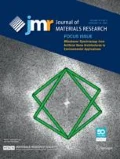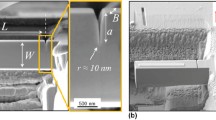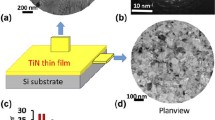Abstract
The fracture toughness of NiAl single crystals is evaluated with a new method based on the J-integral concept. The new technique allows the measurement of continuous crack resistance curves at the microscale by continuously recording the stiffness of the microcantilevers with a nanoindenter. The experimental procedure allows the determination of the fracture toughness directly at the onset of stable crack growth. Experiments were performed on notched microcantilevers which were prepared by focused ion beam milling from NiAl single crystals. Stoichiometric NiAl crystals and NiAl crystals containing 0.14 wt% Fe were investigated in the so-called “hard” orientation. The fracture toughness was evaluated to be 6.4 ± 0.5 MPa m1/2 for the stoichiometric sample and 7.1 ± 0.5 MPa m1/2 for the iron containing sample, indicating that the addition of iron enhances the ductility. This effect is intensified with ongoing crack propagation where the Fe-containing sample exhibits a stronger crack resistance behavior than the stoichiometric NiAl single crystal. These findings are in good agreement with macroscopic fracture toughness measurements, and validate the new micromechanical testing approach.







Similar content being viewed by others
References
D. Di Maio and S.G. Roberts: Measuring fracture toughness of coatings using focused-ion-beam-machined microbeams. J. Mater. Res. 20 (2), 299 (2005).
J. Schaufler, C. Schmid, K. Durst, and M. Göken: Determination of the interfacial strength and fracture toughness of a-C:H coatings by in situ microcantilever bending. Thin Solid Films 522, 480 (2012).
K. Matoy, H. Schönherr, T. Detzel, T. Schöberl, R. Pippan, C. Motz, and G. Dehm: A comparative micro-cantilever study of the mechanical behavior of silicon based passivation films. Thin Solid Films 518 (1), 247 (2009).
G. Žagar, V. Pejchal, M.G. Mueller, L. Michelet, and A. Mortensen: Fracture toughness measurement in fused quartz using triangular chevron-notched micro-cantilevers. Scr. Mater. 112, 132 (2016).
B.N. Jaya, C. Kirchlechner, and G. Dehm: Can microscale fracture tests provide reliable fracture toughness values? A case study in silicon. J. Mater. Res. 30 (5), 686 (2015).
M.G. Mueller, V. Pejchal, G. Žagar, A. Singh, M. Cantoni, and A. Mortensen: Fracture toughness testing of nanocrystalline alumina and fused quartz using chevron-notched microbeams. Acta Mater. 86, 385 (2015).
J.P. Best, J. Zechner, I. Shorubalko, J.V. Oboňa, J. Wehrs, M. Morstein, and J. Michler: A comparison of three different notching ions for small-scale fracture toughness measurement. Scr. Mater. 112, 71 (2016).
D.E.J. Armstrong, M.E. Rogers, and S.G. Roberts: Micromechanical testing of stress corrosion cracking of individual grain boundaries. Scr. Mater. 61 (7), 741 (2009).
G. Bergmann and H. Vehoff: Effect of environment on the brittle-to-ductile transition of pre-cracked NiAl single and polycrystals. Mater. Sci. Eng., A 192–193, 309 (1995).
F. Thome, M. Göken, and H. Vehoff: Study of the fracture behavior in soft and hard oriented NiAl single crystals by AFM. Intermetallics 7 (3–4), 491 (1999).
J. Ast, T. Przybilla, V. Maier, K. Durst, and M. Göken: Microcantilever bending experiments in NiAl—Evaluation, size effects, and crack tip plasticity. J. Mater. Res. 29 (18), 2129 (2014).
S. Wurster, C. Motz, and R. Pippan: Characterization of the fracture toughness of micro-sized tungsten single crystal notched specimens. Philos. Mag. 92 (14), 1803 (2012).
C. Bohnert, N.J. Schmitt, S.M. Weygand, O. Kraft, and R. Schwaiger: Fracture toughness characterization of single-crystalline tungsten using notched micro-cantilever specimens. Int. J. Plast. 81, 1 (2016).
G. Bergmann and H. Vehoff: Precracking of NiAl single crystals by compression-compression fatigue and its application to fracture toughness testing. Scr. Metall. Mater. 30 (8), 969 (1994).
F. Iqbal, J. Ast, M. Göken, and K. Durst: In situ micro-cantilever tests to study fracture properties of NiAl single crystals. Acta Mater. 60 (3), 1193 (2012).
ASTM International: ASTM E1820–13 Standard Test Method for Measurement of Fracture Toughness, Vol. 03.01 (ASTM International, West Conshohocken, 2014); pp. 1–54.
N. Rusović and H. Warlimont: The elastic behaviour of β2-NiAl alloys. Phys. Status Solidi A 44 (2), 609 (1977).
G.C. Sih and H. Liebowitz: On the Griffith energy criterion for brittle fracture. Int. J. Solids Struct. 3 (1), 1 (1967).
ASTM International: ASTM E399–90 Standard Test Method for Plane-strain Fracture Toughness of Metallic Materials, Vol. 03.01 (ASTM International, West Conshohocken, 1991); pp. 1–34.
F. Ebrahimi and S. Shrivastava: Brittle-to-ductile transition in NiAl single crystal. Acta Mater. 46 (5), 1493 (1998).
R. Darolia, D. Lahrman, and R. Field: The effect of iron, gallium and molybdenum on the room temperature tensile ductility of NiAl. Scr. Metall. Mater. 26 (7), 1007 (1992).
A.J. Bradley and A. Taylor: An x-ray analysis of the nickel–aluminium system. Proc. R. Soc. A 159 (896), 56 (1937).
G.R. Irwin: Analysis of stresses and strains near the end of cracking traversing a plate. J. Appl. Mech. 24, 361 (1957).
R.D. Noebe, R.R. Bowman, and M.V. Nathal: Physical and mechanical properties of the B2 compound NiAl. Int. Mater. Rev. 38 (4), 193 (1993).
Y. Wei and J.W. Hutchinson: Steady-state crack growth and work of fracture for solids characterized by strain gradient plasticity. J. Mech. Phys. Solids 45 (8), 1253 (1997).
D. Broek and H. Vlieger: The Thickness Effect in Plane Stress Fracture Toughness (National Aerospace Institute, Amsterdam, Report 74032, 1974).
D. Kupka and E.T. Lilleodden: Mechanical testing of solid-solid interfaces at the microscale. Exp. Mech. 52 (6), 649 (2012).
ACKNOWLEDGMENTS
The authors gratefully acknowledge the funding of the German Research Council (DFG), which within the framework of its ‘Excellence Initiative’ supports the cluster of Excellence ‘Engineering of Advanced Materials’ at the University of Erlangen-Nürnberg. Lisa Freund and Benedikt Schönberger are gratefully acknowledged for their support with the TEM-analysis and sample preparation.
Author information
Authors and Affiliations
Corresponding author
Additional information
This author was an editor of this journal during the review and decision stage. For the JMR policy on review and publication of manuscripts authored by editors, please refer to http://www.mrs.org/jmr-editor-manuscripts/.
APPENDIX
APPENDIX
A(1). Data correction for the penetration of the indenter
Due to the use of a sharp wedge-type indenter, the measured data needs to be corrected for indentations made into the cantilevers. As the correction for the indentation depends on the cantilever width B which was not constant for all samples tested, several imprints were performed into a FIB-milled H-bar of variable width which is shown in Fig. A1(a). The resulting “displacement-load” and “contact stiffness-load” responses for an imprint in this bar at a width of 12.9 µm (red rectangle), which corresponds to one of the used cantilever widths in this study, are depicted in Fig. A1(b) and A1(c), respectively. It is assumed that the measured displacement is the sum of the bending displacement and the indentation into the cantilever. From those reference indentations into the bulk the indentation depth at a given load can be measured and described by a polynomial fit function. The indentation depth is then subtracted from the measured displacement in the bending experiment. Similar adjustments are needed for the correction of the stiffness. The experimentally measured harmonic stiffness Smeasured is a function of the contact stiffness Simprint due to the imprint and of the requested bending stiffness of the cantilever Scantilever. During the indentation of the bar, the stiffness is continuously recorded and the data are again fitted. As demonstrated by Kupka and Lilleodden,27 the bending stiffness of the cantilever can be calculated by applying the model of two springs connected in series leading to the following:
A(2). Stiffness signal of an un-notched cantilever
To attribute a decrease in cantilever stiffness purely to crack growth and consequently a reduction in cross-section, bending experiments were performed on un-notched cantilevers. These investigations were performed on single-crystalline tungsten. The force-displacement data as well as the stiffness evolution during elastic–plastic deformation are shown in Fig. A2(a).
The stiffness stays constant throughout the whole experiment. Initially there is a linear-elastic loading segment, followed by a pronounced hardening regime. Finally, a steady-state deformation behavior after a displacement of ∼700 nm is reached, where the applied force stays constant. The SEM image in Fig. A2(b) shows the sample after testing. An imprint of the sharp wedge indenter as well as distinct slip traces are visible on the surfaces of the beam.
Rights and permissions
About this article
Cite this article
Ast, J., Merle, B., Durst, K. et al. Fracture toughness evaluation of NiAl single crystals by microcantilevers—a new continuous J-integral method. Journal of Materials Research 31, 3786–3794 (2016). https://doi.org/10.1557/jmr.2016.393
Received:
Accepted:
Published:
Issue Date:
DOI: https://doi.org/10.1557/jmr.2016.393






